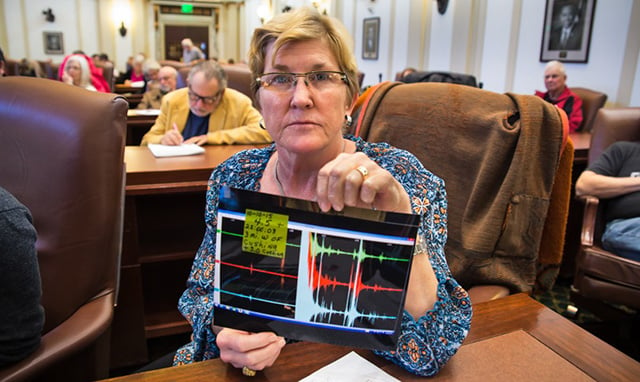
There is a general consensus in Oklahoma that the record-breaking number of earthquakes occurring in the state are caused by the disposal of fracking wastewater in injection wells. But there’s no agreement on what to do to stop them.
“We are human guinea pigs in a fracking industry experiment,” Angela Spotts, founder of Stop Fracking Payne County and a Stillwater, Oklahoma homeowner, told DeSmog. “Regulators tell us they can get the earthquakes under control as they tinker with the quantity that wastewater wells are allowed to inject into the ground. But despite their efforts, the quakes have continued.”
Spotts’ group has called for a moratorium on injection wells that dispose of fracking wastewater. “Shutting the wells down stopped the earthquakes that hit Arkansas. That is what we need to do here too,” Spotts said.
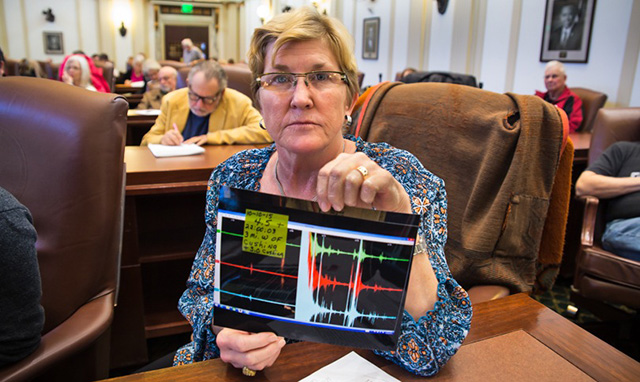 Angela Spotts at the earthquake hearing in the State Capitol. (Photo: Julie Dermansky)
Angela Spotts at the earthquake hearing in the State Capitol. (Photo: Julie Dermansky)
Matt Skinner, spokesman for the Oklahoma Corporation Commission (OCC), the agency that regulates the state’s oil and gas industry, conceded that, “in a perfect world, shutting down all the wells in ‘the area of concern,’ if done gradually, would be ideal.” But he told DeSmog that is not possible because of “private property rights.”
He is hopeful the OCC’s latest regulatory measures calling for operators to cut back the volume of wastewater they inject will stop the seismic activity. And now that a deal has been a struck with SandRidge Energy, the only company that refused to comply with the agency’s directive, he thinks the earthquakes could abate.
Though one of SandRidge’s wells will be operated for research purposes under the OCC’s deal, Skinner said he doesn’t see Oklahomans as guinea pigs.
“What the agency is doing with SandRidge Energy isn’t an experiment – it is research,” he insists.
But Emily Lane, a resident of Greenbrier, Arkansas, and co-director of a documentary about earthquakes in Arkansas, described her community as “human guinea pigs,” when it was in the middle of a seismic storm in 2010.
In her documentary, “Land of Opportunity,” she and her brother read from transcripts of a permit hearing for a wastewater injection well obtained by a Freedom of Information Act request. At the hearing, Arkansas regulators acknowledged seismic activity could be an outcome of permitting injection wells, but they authorized the permit anyway.
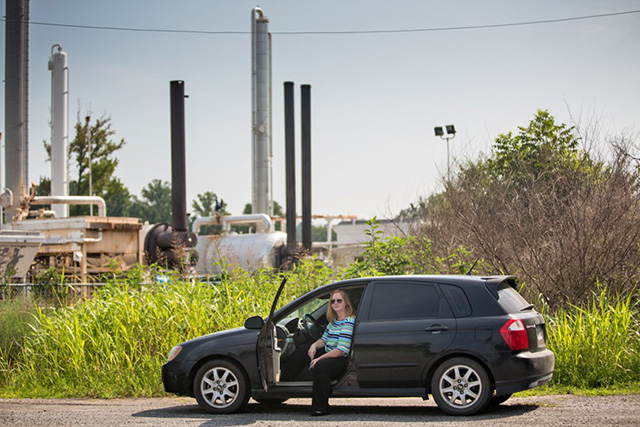 Emily Lane in front of a compressor station in Faulkner County, Arkansas, where she conducted multiple air tests for a nationwide study on air pollution at fracking industry sties. (Photo: Julie Dermansky / Ocean 8 Films)
Emily Lane in front of a compressor station in Faulkner County, Arkansas, where she conducted multiple air tests for a nationwide study on air pollution at fracking industry sties. (Photo: Julie Dermansky / Ocean 8 Films)
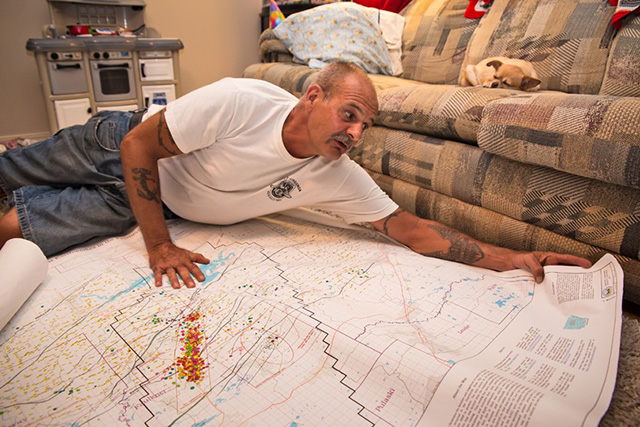 Dirk DeTurck with a map of Faulkner County, Arkansas, that illustrates the earthquake swarm. (Photo: Julie Dermansky / Ocean 8 Films)
Dirk DeTurck with a map of Faulkner County, Arkansas, that illustrates the earthquake swarm. (Photo: Julie Dermansky / Ocean 8 Films)
Dirk DeTurck, an Arkansas resident who experienced the Guy-Greenbrier earthquake swarm, commiserates with Oklahomans. “I feel their pain,” he told DeSmog.
He wants Oklahomans who are considering joining a class action lawsuit to know that no one wins anything but the lawyers.
“People didn’t realize that signing up could mean losing their freedom of speech once a settlement is reached,” DeTurk said. “The settlement in Greenbrier required people to sign a nondisclosure agreement. By the time they realized how little money they would get, they wished they hadn’t participated.”
For DeTurck, following the news in Oklahoma is like déjà vu. “It doesn’t take a rocket scientist to figure out what is causing the quakes or what you have to do to stop them,” he said.
It took a 4.7 magnitude earthquake that shook Greenbrier in 2011 to convince regulators to shut down the area’s wells. “Since then, the fracking wastewater has been trucked to Oklahoma. I see trucks that are hauling wastewater heading east on Interstate 40 for the state line all the time,” said DeTurck.
Skinner admits the OCC does not know exactly how much wastewater is coming into Oklahoma from Arkansas and other states. But he doesn’t think it is very much. The agency can’t track how much is delivered to private wells, but can obtain the records of what is received at commercial ones.
Ed Henshaw, an Oklahoma resident who lives near the Arkansas state line, doesn’t agree. During a hearing on earthquakes at the state capitol on January 15, he said he sees semi-truck after semi-truck hauling wastewater from Aransas on Interstate 40 across the state line into Oklahoma.
Enid News coverage cites Oklahoma Corporation Commission reports that the state receives wastewater from Texas, Kansas, New Mexico, Colorado and Arkansas.
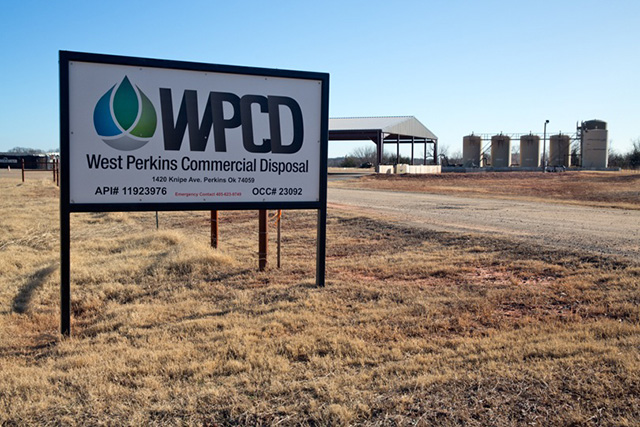 Wastewater injection well site in Perkins, Oklahoma. (Photo: Julie Dermansky)
Wastewater injection well site in Perkins, Oklahoma. (Photo: Julie Dermansky)
Even if the OCC wanted to stop waste coming in from other states, it couldn’t, Skinner explained to DeSmog, because of interstate commerce rules. The only thing the agency can do is ask Oklahoma companies to voluntarily comply with directives limiting the volume of the fracking wastewater being injected.
After the US Geological Survey predicted a 5.5 magnitude earthquake was probable, Ariel Ross, a professor of English at Oklahoma State University (OSU), began to pay more attention to the earthquakes.
And ever since former Oklahoma State seismologist Austin Holland, who left his post in July 2015, said a 7.0 magnitude was possible, not a day goes by that the earthquakes aren’t on Ross’s mind.
When the epicenter of one of the earthquakes was a half-mile from her son’s school, Ross started to worry about the school’s structural integrity, and whether the kids had earthquake drills.
As far as she knows, no one has checked the school’s structural stability, and though they have active shooter drills and tornado drills, “earthquake drills have been deemed too scary, so they aren’t done at all,” she said.
School administrators’ refusal to face the possibility of a big quake alarmed her, but she admitted she doesn’t have an emergency plan if the “big one” hits, either.
Rep. Mike Shelton introduced legislation that would require earthquake drills at schools, but it was voted down. He is trying again in the coming session.
Ross keeps a bowl in her kitchen with pieces of brick that have popped off the walls of the apartment she rents in downtown Stillwater. She doubts that many buildings have had their structural integrity checked since the seismic activity began, including the one she lives in.
She is right. The Oklahoman reported on January 24:
“Two years ago, Oklahoma set out to survey its most earthquake-vulnerable buildings. Today, state officials are no closer to knowing which of hundreds of public structures would be most likely to collapse during a severe temblor.”
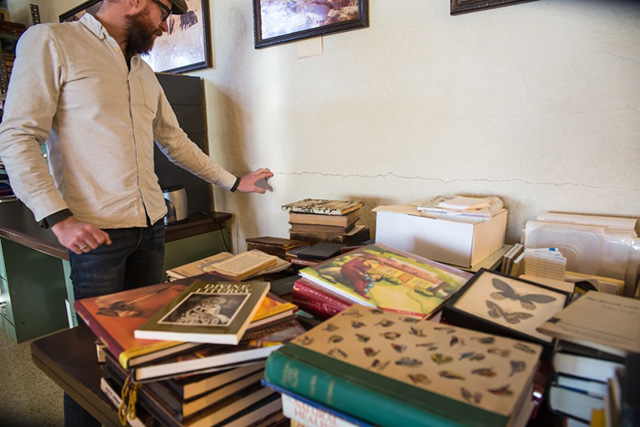 Priest Brad Wilson next to a newly discovered crack in the library at St. Francis of the Woods. (Photo: Julie Dermansky)
Priest Brad Wilson next to a newly discovered crack in the library at St. Francis of the Woods. (Photo: Julie Dermansky)
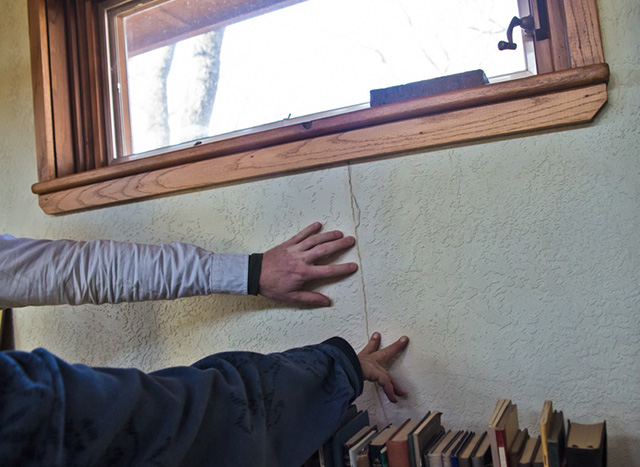 Crack in the library at St. Francis of the Woods. (Photo: Julie Dermansky)
Crack in the library at St. Francis of the Woods. (Photo: Julie Dermansky)
At St. Francis of the Woods, an ecumenical spiritual retreat center in Coyle, Oklahoma, Priest Brad Wilson gave DeSmog a tour, pointing out the earthquake damage. He found problems he hadn’t previously noticed.
“I guess I’m in denial about the possible danger,” Wilson said. “Maybe it is time to get a structural engineer here.”
Retired AT&T employee Mark Crimson has a seismometer supplied by Oklahoma State University on his land. He hooked it up to his computer so he can watch the quakes in real time. OSU students chose Crimson’s land for their study because he lives directly above a fault line.
“The OCC is gambling with everybody’s lives,” Crimson told DeSmog.
He doesn’t think the OCC’s regulatory measures will be enough to stop the seismic storm.
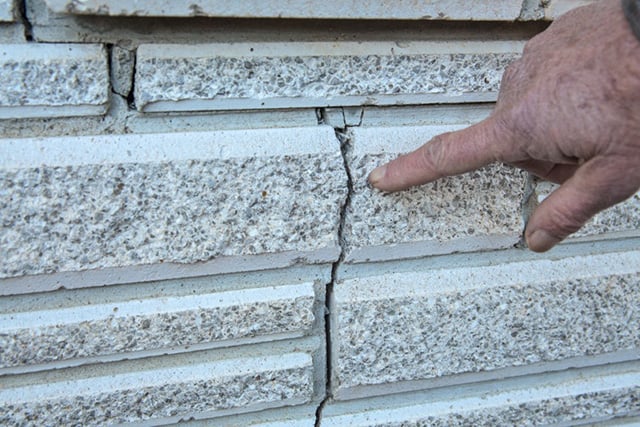 One of many cracks on Mark Crimson’s house. (Photo: Julie Dermansky)
One of many cracks on Mark Crimson’s house. (Photo: Julie Dermansky)
“When the USGS comes out with a new earthquake hazard map, it is going to change everything,” Crimson said. The promised map is overdue. “No one is going to want to insure the houses here once it comes out.”
Spotts is starting to think the only way to protect yourself is to leave the state. When her group first pushed for a moratorium in 2014, the state passed a law making local moratoriums illegal.
Two recent public meetings addressing the earthquakes came after the deadline for politicians to submit new legislation for the next session. “Now the only hope to get a moratorium is if emergency legislation Rep. Morrissette plans to introduce calls for a moratorium on saltwater injection wells and if it passes,” Spotts said.
Crimson says if a 7.0 magnitude earthquake hits, it could take out 200 miles of the state’s infrastructure. He doesn’t expect to survive such a quake, and will go down with his house. “Only the survivors will suffer,” he said.
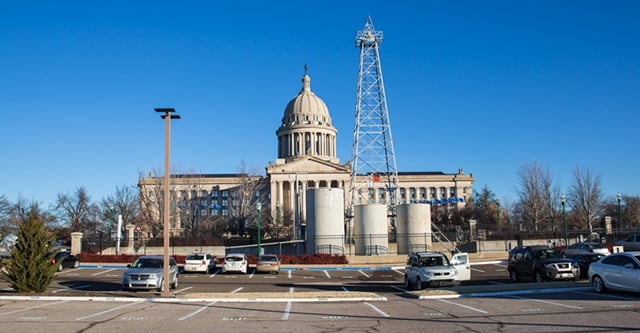 Phillips 66 oil drilling derrick with petroleum tanks in the parking lot at the Capitol Building in Oklahoma City. (Photo: Julie Dermansky)
Phillips 66 oil drilling derrick with petroleum tanks in the parking lot at the Capitol Building in Oklahoma City. (Photo: Julie Dermansky)
Join us in defending the truth before it’s too late
The future of independent journalism is uncertain, and the consequences of losing it are too grave to ignore. To ensure Truthout remains safe, strong, and free, we need to raise $27,000 in the next 24 hours. Every dollar raised goes directly toward the costs of producing news you can trust.
Please give what you can — because by supporting us with a tax-deductible donation, you’re not just preserving a source of news, you’re helping to safeguard what’s left of our democracy.